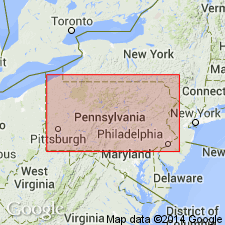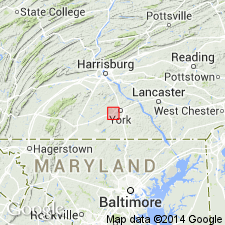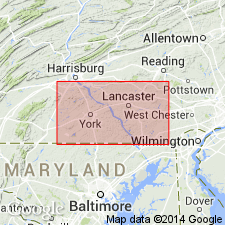
- Usage in publication:
-
- Kinzers formation*
- Modifications:
-
- Named
- Dominant lithology:
-
- Dolomite
- Shale
- AAPG geologic province:
-
- Piedmont-Blue Ridge province
Summary:
Kinzers formation (new name) described as siliceous banded dark-blue dolomite, resting on 50 ft (in places) of blue hackly shale (containing Olenellus fauna), and at base, a few thin beds of impure dolomite. Thickness 150 ft, thins to 25 ft south of Welsh Mountain. Underlies Ledger dolomite and overlies Vintage dolomite, the three formations being considered equivalent to Tomstown dolomite.
Source: GNU records (USGS DDS-6; Reston GNULEX).

- Usage in publication:
-
- Kinzers Formation
- Modifications:
-
- Revised
- AAPG geologic province:
-
- Piedmont-Blue Ridge province
Summary:
Kinzers Formation in the West York block of the Conestoga Valley, York Co., PA, is here subdivided into the basal Emigsville Member (Gohn, 1976), the York Member (new name), and the Greenmount Member (new name). Emigsville is the most laterally persistent. Thickness in the report area is approximately 100 to 200 ft. York Member is well exposed in Pit 1 at the Delta Carbonate Quarry. York previously informally designated Thomasville member by Gohn (1976). Thickness approximately 1000 to 1200 ft. Consists very pure to moderately pure carbonates. Greenmount Member described as sandstone and siltstone with very little carbonate where weathered. May be equivalent to Gohn's (1976) Longs Park member in Lancaster Co. Thickness varies from 50 ft to 180 ft. Authors state, "The long history of use of the name Kinzers dictates the need for its continued use. The rocks included within the Kinzers Formation, however, vary dramatically from the type locality in Lancaster Co. to the York Valley portion of the Conestoga Valley. The unit thickens from about 200 ft to 1450 ft. . . . There may be some logic, therefore, in assigning group status to the name." Underlies Ledger Formation. Age of the Kinzer in report area is Early Cambrian.
Source: GNU records (USGS DDS-6; Reston GNULEX).

- Usage in publication:
-
- Kinzers Formation
- Modifications:
-
- Overview
- AAPG geologic province:
-
- Piedmont-Blue Ridge province
Summary:
All three members of the Kinzers--the Emigsville, the York, and the Greenmount--are assigned to off-shelf environments. The basal Emigsville is a laterally persistent basinal facies with two components. The lower third is argillaceous dolomite and dolomitic limestone, overlain by shale. The York includes well-bedded lime mudstones, oolitic and bioclastic lime grainstones, and minor occurrences of periplatform breccia. [York was called Thomasville Member by Gohn (1976).] The Greenmount Member is a distinctive, impure carbonate (dark, pyritic, laminated to nodular limestone) with abundant fine-grained siliciclastic sediment which occurs as black shaly interbeds and dispersed silt-sized quartz and feldspar grains. Age of the Kinzers is Early Cambrian.
Source: GNU records (USGS DDS-6; Reston GNULEX).
For more information, please contact Nancy Stamm, Geologic Names Committee Secretary.
Asterisk (*) indicates published by U.S. Geological Survey authors.
"No current usage" (†) implies that a name has been abandoned or has fallen into disuse. Former usage and, if known, replacement name given in parentheses ( ).
Slash (/) indicates name conflicts with nomenclatural guidelines (CSN, 1933; ACSN, 1961, 1970; NACSN, 1983, 2005, 2021). May be explained within brackets ([ ]).

